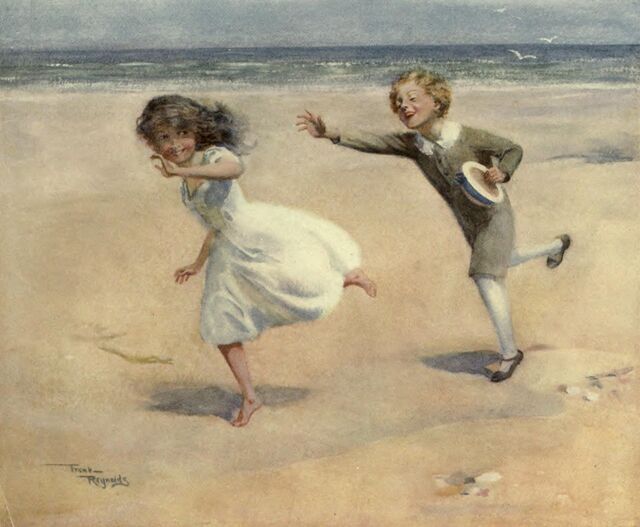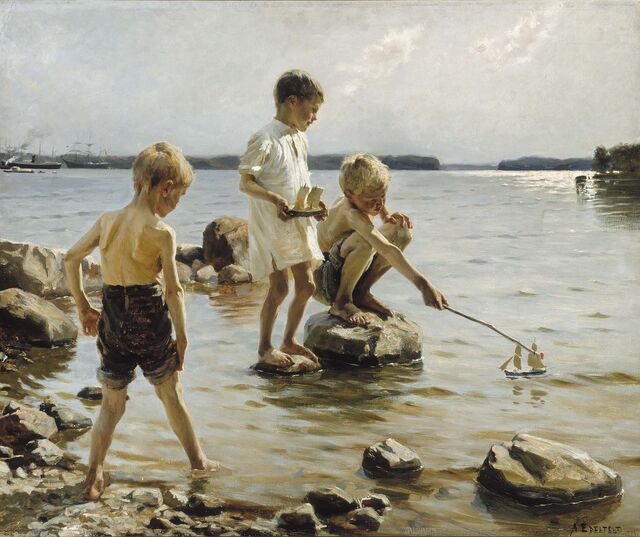Lessons from my kids on how to feel alive

What does it feel like to be alive? Living, you stand under a waterfall. You leave the sleeping shore deliberately; you shed your dusty clothes, pick your barefoot way over the high, slippery rocks, hold your breath, choose your footing, and step into the waterfall. The hard water pelts your skull, bangs in bits on your shoulders and arms … It is time pounding at you, time. Knowing you are alive is watching on every side your generation’s short time falling away as fast as rivers drop through air, and feeling it hit.
— Annie Dillard, An American Childhood
What can we learn from children on how to feel alive? Much, I think.
When you imagine the quintessential summer break for an American child, you might envision long days spent playing outside in golden sun, sometimes listless or unstructured, sometimes filled with the bustle and activities of day camps. The drawn-out weeks punctuated, perhaps, by weekend trips to the local beach or ice cream parlor.
For my family, this semi-idyllic vision of summer mostly mirrors reality, as long as you willingly ignore the frequent cries of “I’m bored” or “He called me a moron” that accompany long, hot days spent home from school. As residents of Northern California we, too, even visit the beach, though maybe not as often as we’d like. Summer might bring us only a small handful of trips to the sea.
On California’s northern coast, the ocean bites with frigid teeth, and thick blankets of fog settle down to nap on the seashore for days or weeks at a time, blocking the sun, chilling the air, reducing visibility to near zero. Beach days are rare here in summer. Better to come in September or October, when the extreme temperature differential between coast and inland subsides and the fog belt dissipates for a few glorious, sun-soaked weeks.
This past week, however, climate change gave us the “gift” of a record-breaking heat wave. It was hot nearly everywhere in California. So we packed the car and headed to our favorite spot on a thin strip of sand along the Point Reyes National Seashore to try and cool down.
For my kids, trips to the beach are a rare enough occurrence that each one feels fresh and new and exciting. Crossing that threshold between the parking lot and the sand dunes is like crossing the threshold to adventure. For them, a simple day at the beach is effortlessly visceral in a way that, as an adult, I find I can only approach asymptotically through sustained effort. Thoughts get in the way which I must repeatedly discard or ignore. Did we pack enough snacks? Are the kids too far out in the water for safe swimming? What about that meeting I need to prepare for on Monday morning? Children worry about none of this because not just because they have no real responsibilities, but because being out in nature lulls them into a pure and playful presence. There—away from toys and screens and play structures and the milieu of modern childhood—they come alive.
While I love the prose and imagery of Annie Dillard’s waterfall metaphor, I also feel it misses the truth. It is tainted by the experience and maturity of adulthood. Hers is the reminiscence of an adult looking back on childhood with adult-colored lenses. We—the grown-ups—lost in moments of reverie may feel the hit and sting of time “falling away” moment to moment, but a child at play feels no such thing. I was reminded of this while watching my own children on the beach last week—squealing and giggling in the surf, scouring the sand for shells and sand dollars, writing their names in the sand with sticks. Time did not pelt them at all; it merely ceased to exist.
At the end of the afternoon, when my wife and I tried to pry them out of the water and wet sand, my kids were astonished to find that we were leaving so soon. “We’ve been here for five hours,” I said. “We have to get home and have dinner.” I could have said “ten hours” or “one hundred hours” and it wouldn’t have mattered. To them the experience was but an instant, their faces souring at the idea that the adventure had come so abruptly to an end. Extraction was a thirty-minute long chore.
This is the first lesson children give us on how to feel alive: Let go of time. Be present.
Extracting kids from deep play is always hard, but I’ve found it to be twice as difficult when my kids are playing in nature. It seems to be less of a challenge when we’re at a museum or the neighborhood park. Why? Why do children seem to come most alive in nature, when their only toys are a few sticks and rocks, or a single leaf idly floating down a creek?

We shouldn’t feel surprised that Dillard’s metaphor for living draws from her own memories of nature. Nature envelopes us with sensory texture unmatched by anything man-made, with its myriad folds of depth and nuance. The difference between playing at the beach and playing on a playground is the difference between wandering a landscape with the beauty of infinite fractal complexity versus walking on the featureless surface of smooth ball bearing. One invites us to explore its hidden secrets, the other has no secrets. Again, from Dillard:
What do I make of all this texture? What does it mean about the kind of world in which I have been set down? The texture of the world, its filigree and scrollwork, means that there is the possibility for beauty here, a beauty inexhaustible in its complexity, which opens to my knock, which answers in me a call I do not remember calling, and which trains me to the wild and extravagant nature of the spirit I seek.
But I also think it’s more than this. Nature’s texture may hold our attention, but it’s something else, something more primal about being out in the natural world that lends an element of aliveness: the thrill of risk.
Watching my kids playing in the waves, I was reminded that to feel alive children must engage with the real world, and the real world feels “real” precisely because our actions there have consequences. One of the stupidest toys we ever bought our kids was a set of wooden toy knives and velcro “fruit” that they could “cut” by running the knife through the velcro. It held their attention for a few minutes at a time for a few weeks at best, then was eventually left to settle at the bottom of the toy bin with other forgotten plastic detritus. Cutting velcro fruit is not a real activity; cutting real fruit with a sharp knife—to engage with the world like adults—that’s what kids want to do. The risk, of course, is that they could cut off their fingers. (I’m not suggesting that you lend a three-year-old your chef’s knife!) But the risk is also—for older children with adult supervision at least—that they could simply do it incorrectly. They could make a mistake. There is risk, but there is also the possibility of mastery.
With calm seas and the watchful eye of a parent or lifeguard, children splashing around in the waves is a relatively safe activity in the grand scheme of things. But for my kids, watching them play in the ocean that day was like watching them dance with a playful tiger, beautiful and inspiring, but overshadowed by the nerve-wracking realization that one false move of over-confidence might immediately turn the laughter into tears … or worse. My gut prevented me from ever fully relaxing during those long hours. Still, I wouldn’t have had it any other way. As our greatest teacher, Nature can both pull us into transcendent experiences of awe and instill within us the deep humility of our insignificance, but to learn either of these lessons we must first be willing to accept the risks that come with entering the doors of her school.
In The Hero’s Journey, Joseph Campbell writes:
People say that what we’re all seeking is a meaning for life. I don’t think that’s what we’re really seeking. I think that what we’re seeking is an experience of being alive, so that our life experiences on the purely physical plane will have resonances with our own innermost being and reality, so that we actually feel the rapture of being alive.
Few experiences provide us with more opportunities to feel this rapture than the simple experiences of natural wonder. And this, I think, is the second lesson I learned from my kids on how to feel alive: Get outside.
If you head to Point Reyes early in the morning, remember to pack patience and a light sweater. The journey west from the cities and towns of Marin may begin under the splendor of sunshine and blue skies, but as you approach the coast, you may find yourself approaching a looming wall of dark clouds. Walking onto the sand at 10am, laden with bags and towels and coolers and other beach-day accoutrements, expect to wade through a blustery, pallid soup of fog. Do not despair, for though Nature in Northern California is fickle, she often rewards the most resilient and patient. Within an hour, the fog may begin to melt away, and if you’re lucky you’ll be treated with the resplendent glory of an unspoiled land, where verdant hills speckled with wildflowers crumble into the bosom of the sea.
If you go, leave your phone and forget your watch. Be a kid. Play. Dance. Wonder. Try to find that elusive experience of being alive.